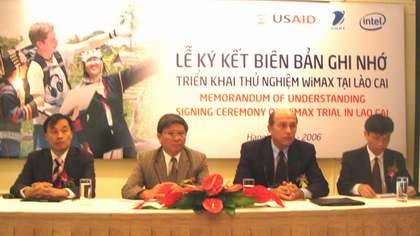On June 14th in Hanoi, Intel, the Data Communication and Computing Company (VDC), and the United States Agency for International Development (USAID) signed a memorandum of understanding to collaborate on WiMAX trials in Lao Cai province. Lao Cai province was selected to implement trials of wireless broadband technology aimed at providing access to modern information and communication worldwide for remote and rural areas.
According to this agreement, together with Lao Cai province and local partners, the three parties will collaborate to implement WiMAX technology trials over an 8-month period (starting from July 2006), utilizing one main transmission station and 18 civil connection stations in Lao Cai province. Other programs are also in the planning stages to use satellites to connect and expand WiMAX to hard-to-reach areas by road.
Commenting on this program, Mr. Pham Long Tran, Chairman of the Vietnam Posts and Telecommunications Group (VNPT), stated: “We believe that the implementation of WiMAX trials in Lao Cai will be successful and become a model for deployment in other remote areas, contributing to improving the lives of the people. VNPT is committed to providing comprehensive support for the project. Ultimately, it is the people who will benefit. WiMAX will help connect urban and rural areas, industry and agriculture.”
Mr. Gerry Greeve, Vice President of Intel’s Communications Group, remarked: “Intel believes that WiMAX technology can help Vietnam become a dynamic economy and society. We are cooperating with the government and environmental technology agencies to enhance access to technology and achieve digital outcomes through the deployment of modern and synchronized wireless broadband technology. This implementation will also assist Vietnam and its partners in reaching new heights in the digital Southeast Asia, making the region globally competitive. High-speed Internet connectivity helps bridge the digital divide between urban and rural areas.”
 |
Participants in the trial respond to media interviews. |
Mr. Tim Beans, USAID’s Regional Development Manager for Asia (RDMA), stated: “Over the past decade of social economic reform, Vietnam’s human development program has reduced the poverty rate by 33%. In the next decade, information and communication technology along with access to global knowledge will be key for Vietnam to integrate into the global economy and become a highly competitive nation. Equipping both the private and public sectors in Vietnam with leading technologies is increasingly creating job opportunities and fostering prosperity as regional and international markets grow and develop.
According to Mr. Vu Hoang Lien, Director of VDC: ”We will conduct a comprehensive assessment of this trial, not merely focusing on the technology aspect, but also on the project’s impact on the community and the applicability of services,… VDC aims to transform Vietnam into an information and communication technology hub for Southeast Asia by bringing the entire country into the broadband age, increasing global competitiveness, and opening equitable opportunities that fundamentally change lives and the economy.
Additionally, Mr. Lien noted that customers have high expectations for Mobile WiMAX, hence, the next phase will involve testing this area.
According to Mr. Pham Anh Chien, Head of System Integration at VDC, the WiMAX trial in Lao Cai is being conducted at frequencies ranging from 3.3 to 3.4 GHz. Of the 18 surveyed locations, 6 schools, healthcare facilities, local government offices, and small to medium enterprises were selected. Notably, a farming household without a phone or Internet connection has also been chosen to participate in the WiMAX trial, enabling this family to communicate with their child who is working far from home. Lao Cai was selected for the trial due to its remote areas, which still have many gaps in IT and telecommunications.
Mr. Chien also mentioned that the selected sites will be equipped with computers, devices, VoIP phones, and Wi-Fi. In the initial phase, voice and Internet services will be tested.
The WiMAX trial program will demonstrate the economic and social benefits of expanding access to advanced information and communication technology services such as VoIP (Voice over Internet Protocol) and modern Internet support for schools, health clinics, training and vocational institutions, local small businesses, hotels, and other social needs—while also supporting priority public services of local governments.
This collaboration is also part of Intel’s Asian Broadband Campaign (ABC), a regional program aimed at accelerating the deployment of wireless broadband in Southeast Asian countries. Intel will provide extensive knowledge of wireless broadband, silicon technology, and technological services to governments, communication management agencies, educational, health, and agricultural sectors, as well as telecommunications providers to help prepare and implement WiMAX technology trials. Compared to wired technology, wireless networks are more cost-effective and faster to build, allowing service providers to be more agile in bringing modern global “knowledge economy” solutions to underserved communities at reasonable costs.
About WiMAX Technology
WiMAX technology, also known as the 802.16 standard, is a rapidly evolving wireless broadband technology with wide deployment capability and is seen as a significant potential solution for the “last mile” to bring high-speed Internet connectivity to homes and workplaces.
While the familiar Wi-Fi technology (802.11a, b, and g) provides connectivity to small areas like offices or public hotspots, WiMAX technology has a broader coverage area, encompassing an entire urban or specific rural area. This technology can deliver data transmission speeds of up to 75 Mbps at each transmission station, covering distances from 2 to 10 kilometers. With such bandwidth, this technology can simultaneously support the connectivity of over 60 businesses at T1/E1 connection speeds and hundreds of households at DSL connection speeds through a single transmission station.
L. Quang



















































